

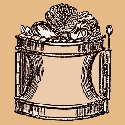 VICTORIAN FOOD MOLDS
VICTORIAN FOOD MOLDS
![]()
 The
food molds shown here are part of a tradition that developed in England between
the Middle Ages and the 19th century. Pudding, ice cream and jellies in the
19th century were symbols of sophistication and status. Pudding also was used
as a love-offering as described in Victorian stories such as Little Women
by Louisa May Alcott, and The Wide, Wide World by E. Wetherell, published
in 1868 and 1850, respectively.
The
food molds shown here are part of a tradition that developed in England between
the Middle Ages and the 19th century. Pudding, ice cream and jellies in the
19th century were symbols of sophistication and status. Pudding also was used
as a love-offering as described in Victorian stories such as Little Women
by Louisa May Alcott, and The Wide, Wide World by E. Wetherell, published
in 1868 and 1850, respectively.
|
Pewter Ice Cream Molds (far left and second from left). With fruit on the tops. Standard hallmark of British Empire in diamond shape in the internal base. Date: July 22nd 1868. This hallmark was used by British manufacturers beginning in 1842. CAS 0389-1268A-C & 0389-0725A-C Pewter Ice Cream Mold (second from right). With grapes and leaves on lid. Standard hallmark of British Empire in diamond shape engraved on lid. Date: June 9th 1877. CAS 0389-1269A-C Pewter Ice Cream Mold (far right). With fruit on lid. British hallmark in the internal base: "BIERTUMPFELL & SON MAKERS 18 ALBANY ST. LONDON." A similar mold is described in Book of Ices, written by Mrs. Marshall and published in 1900. Date: late 19th century. CAS 0389-1270A-D |
![]()
|
|
Iron Fish Mold (left). Used in fish-flavored aspics or mousses.
CAS 0389-0972 French Pewter Mold or Pâté Mold (right). Open at both ends. Presented in Mrs. Marshall's Cookery Book (1887-1900). CAS 0389-0715A,B |
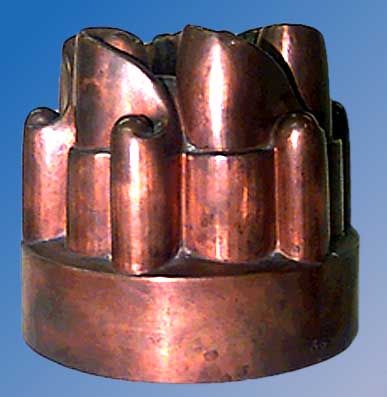 |
Copper Jelly Mold. No hallmarks. One like this is in Hampshire County Museum. Date: late 19th century. CAS 0389-0957 |
![]()
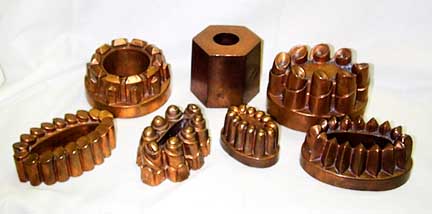 |
Jelly Molds with Cross and Orbe Mark. Date: late 19th century. Back row, left to right: CAS 0389-0958, 0389-0961, 0389-0710 Front row, left to right: CAS 0389-0711, 0389-0971, 0389-0824, 0389-0970 |
|
1 pkg of flavored gelatin 1 cup hot water 2/3 cup fruit liqueur Fruit to decorate the inside of the jelly |
3 large egg yolks 1 cup warmed milk 1/2 cup heavy cream 3 tablespoons extra-fine sugar |
| Melt half the gelatin in half the water. Gradually add the remaining water and 1/4 cup of the liqueur and allow to cool. Using sunflower or similar very light-tasting oil, oil the interior of a 1 quart mold and the exterior of a 1 1/4 pint mold lightly. Pour the jelly mixture into the large mold. Put the smaller mold inside and fill with tins or weights until jelly rises just to the sides of the inner mold. Freeze both molds. When the jelly is completely set, remove the weights and pour a little boiling water into the inside mold. Swish it around for a minute, then lift out inner mold. Return molded gelatin to freezer for several minutes. | Meanwhile slice the fruit thinly, then arrange it in desired pattern inside molded gelatin. Put the egg yolks in a heavy pan or a double boiler and stir in the sugar briskly. Stir mixture continuously over low heat and gradually add the warmed milk. Cook gently until the custard thickens slightly, then remove it from the heat. Melt the remaining gelatin in the remaining liqueur and stir into the custard. Cool completely. Whip the cream with a whisk lightly until it just holds its shape, then fold it into the custard. Spoon the custard mixture carefully into the jelly. Freeze for two hours. To serve, dip the outer mold in hot water and invert onto plate. |
![]()
|
2 oz fresh white bread crumbs 1 round tablespoon castor sugar 4 whole peaches, or 8 large apricots, or 12 Victorian plums |
2 egg yolks 1 egg white 1 tablespoon white wine 1/2 pint double cream |
| Put the bread crumbs in a bowl. Heat the cream in a saucepan until almost boiling. Pour over the crumbs and stir to blend. Cover the bowl and leave until cool, then stir in the egg yolks, wine and sugar. Poach the fruit in a little water until barely tender, then drain. When cool enough to handle, skin the fruit and remove the stones. | Puree the fruit in a sieve or food mill, then stir the puree into the cream and bread crumb mixture. Whisk the egg white until stiff and fold into the mixture. Pour into a shallow oven dish. Bake at 350 F for 40 minutes. Serve hot with a bowl of lightly whipped cream. |
|
Copper Tin Mold (left). Also called baba cake mold or old German pound cake mold. CAS 0389-0928 Copper Tin Mold (center). For old-fashioned puddings. CAS 0389-0708 Oval Copper Mold or Melon Mold (right). A popular pattern in Europe and North America. Used for puddings, ice cream and jelly. The same pattern was advertised in American Home Cookbook (1854). CAS 0389-0705 |
 BIBLIOGRAPHY
BIBLIOGRAPHY
| BERRIEDALE-JOHNSON, MICHELLE The Victorian Cookbook. New York, Interlink Books. 1989 |
| BLACK, MAGGIE & DEIRDRE LE FAYE The Jane Austen Cookbook. Chicago, Chicago Review Press. 1995 |
| BREARS, PETER "Transparent Pleasure: The Story of Jelly: Parts One & Two," Petits Propos Culinaires , No. 53-54. London, London Prospect Books Ltd. |
|
SOBEY, BARBARA & DAMMARIS HAYMAN |
 |
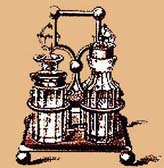 |
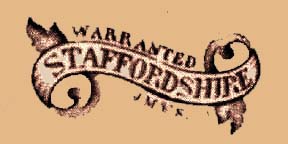 |
 |
|
| Kitchen Technology | Silversmithing | Blue & White Crockery | Food Molds | Victorian Kitchens Home |